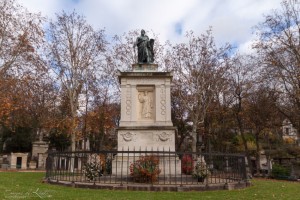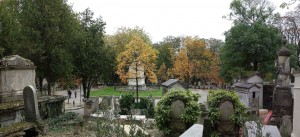Archaeologists often find graves with little to no accompanying documentation of the people buried or their communities and cultures. It is the job of the archaeologist to figure out as much about the deceased as possible by looking at the inscription, composition, and location of their gravestones.
Pictured above is the grave of a Casimir Perier, born on October 21, 1777, died on May 16, 1832. With the Internet, I can easily learn who he was, how he died, when he died, and what he did when he was alive. But what if I didn’t have access to such a large database? If the only clue I had was the gravestone itself, how would I figure out what kind of person was buried there?
I would have to think like an archaeologist.
Perier’s grave is one of the few tombs with it’s own lawn and garden area. In fact, it is completely surrounded by a fence. This discourages the public from walking up to the grave, and suggests that distance between the two was desired at the time of its erection.
Without reading the tomb inscriptions, it’s easy to see that the person buried here was not only important but was prosperous in either money or friends. The monument is made of marble and topped with a bronze statue of Casimir Perier. Marble is more expensive than the stone used for the majority graves seen in the Père Lachaise Cemetery. Furthermore, the grave is almost four meters high, making it one of the tallest and therefore most expensive monuments in the cemetery. The people that buried him made sure his grave was far more impressive than those nearby; a great amount of money went into his grave. Only a wealthy man, or one with wealthy friends could afford to be buried here.
On top of the grave, Perier is garbed in a toga over regular European style clothing, a combination only seen on statues of diplomats. He holds a plaque that reads “ Charte De 1830.” On the bottom of the statue lies an excerpt above lady eloquence that roughly translates to “Seven times elected Deputy Chairman of the Cabinet under Louis Philippe I. Defended eloquence and courage and freedom and national dignity in the interior peace.” I now know exactly who Perier worked for, how long he held his position, when he was most influential, and what direct effect it had on the nation.
Without any information from the internet I’ve discovered that Casimir Perier was known for his eloquence and served as Deputy Chairman of the Cabinet under King Philippe I seven times. He was most influential as Deputy Chairman of the Cabinet in 1830, and was quintessential to upholding France’s dignity. He was greatly valued in life, and his monument in death far outshines those around it. The fencing, however, is used to aesthetically create a barrier from anyone walking through the cemetery. His time as president created disparity between the government and the public.
After confirming that the information gathered from Perier’s tomb is indeed accurate, it’s easy to see why archaeologists use graves to understand the lives of the deceased. The inscription, composition, and location of gravestones are all key in learning more about past communities, and in Caismir Perier’s case, whole nations.
Pictures found at:
http://www.canvas-of-light.com/2010/10/pere-lachaise-cemetery/
https://commons.wikimedia.org/wiki/Category:Grave_of_Casimir_Pierre_Perier
Reference websites:
http://www.britannica.com/biography/Casimir-Pierre-Perier
http://www.archive.org/stream/archivesdelartfr13sociuoft#page/336/mode/2up
For more information:
http://www.biography.com/people/casimir-périer-40984#synopsis
http://www.histoire-image.org/site/oeuvre/analyse.php?i=163 (French)



Cemeteries are fascinating sites for archaeologists and anthropologists looking for clues into the past of a community as well as information about the living. As you pointed out, cemeteries can tell us a great deal about an individual’s socio-economic status, influence and personal life. They also provide insight into how attitudes toward death changed over time. You could use bits of information collected from tombstones to analyze the aspects of gender, class, race and religion in relation to a community. Archaeologists are good at seeing what is hidden when it comes to history and excavation sites. By asking questions such as, ‘What type of members of the community were buried here?’ and ‘Who was left out?’ do we start to dig deeper into the past and find details about a culture and society.
Discovering the hidden context of graves undoubtedly requires hard work; however, accompanying documentation, or a lack thereof, proves to be an equally important factor in deciphering gender, class, and race dynamics in tombstones. The grave of Casimir Perier is of the same caliber as many French monarchs yet there is a lack of cultural identification or recognition with his grave. Analyzing the grave itself revealed that Perier was an important, somewhat controversial figure. In this case, however, only through accompanying text is it possible to exhume past cultural complexities. The paper below explains how Perier’s grave led to the loss of his historical identity and discusses how it was used as sociocultural propaganda
http://discovery.ucl.ac.uk/1317819/1/287474_vol1.pdf
Graves are a great entry point for learning how to think like an archaeology. Everyone has some experience with death and can understand the desire to memorialize those we have lost. The archaeology of schools is similar; shared experience supports understanding. It is when archaeologists study more obscure topics that we sometimes have difficulty explaining the importance of what we do and how we do it. Understanding why one rock is a stone tool and another is just a rock requires experience. Understanding why one rock tells a different story from another requires context. There are lots of stories of past people and places that are worth telling and hearing. I hope we can convey that in ways that keep the past alive for the future.